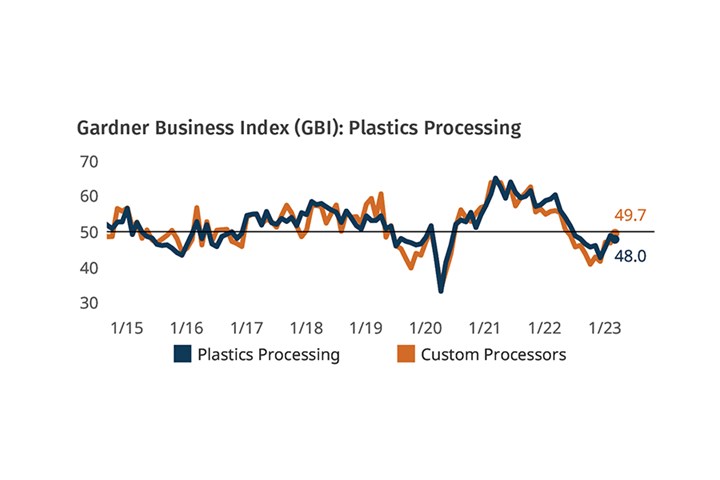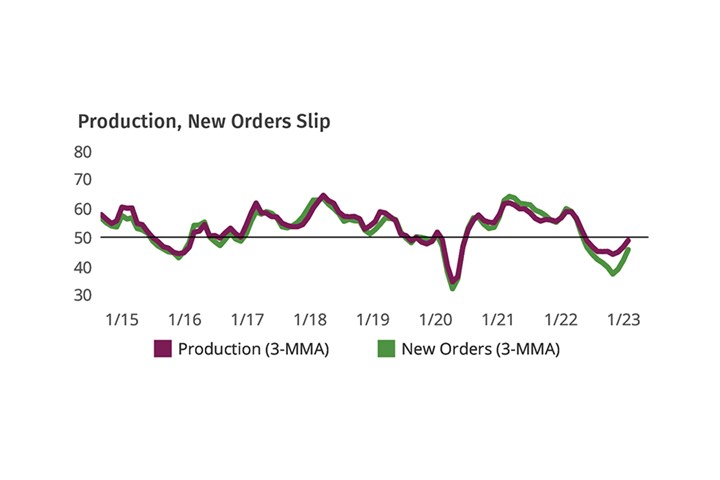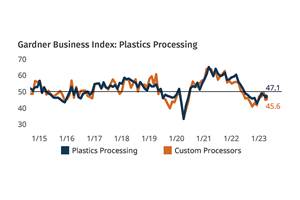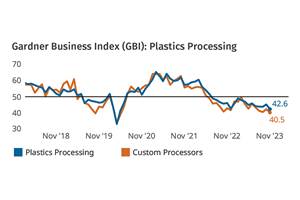Plastics Processing Contracted Again in March
Processing activity contracted for the ninth straight month, and at a faster rate.
The Gardner Business Index (GBI) for Plastics Processing closed March at 48, losing 1.1 of the 3.2 points it gained in February. The index is based on survey responses from subscribers to Plastics Technology. Indices above 50 signal growth; below 50, contraction.
In March, all GBI components moved in the right direction, according to three-month moving averages, though four of six still contracted. New orders contracted the most, with production heading consistently closer to being out of contraction in each month of this year’s first quarter. Employment activity expanded in March to a level last reported in August 2022, ending a five-month contractionary period.

FIG 1 Plastics processing activity contracted again in March for both custom processing and total plastics processing, the former inching ever-so-close to expansion but the latter contracting a little faster.
Backlogs and exports continued to contract for a second and third month straight, respectively, but slower than the month before in both cases. Backlogs reached their October 2022 level, while exports landed close to its May 2022 level.
Supplier deliveries continued to lengthen at a slower rate in March. If this trend that started June 2021 continues, delivery times will eventually shorten.

FIG 2 Two key drivers of plastics processing activity contracted at slower rates in March.
Overall business activity for custom processing, which knocked on the door of expansion in March, had a better month than total plastics processing.
EDITOR’S NOTE: Finding reliable and relevant data to help guide your business is always important, but especially so during challenging economic times. For this reason, the GBI Plastics Processing Index serves as a great tool for making data-driven decisions. Thank you to everyone who has previously completed GBI surveys. Your participation helped increased response in 2021-2022, making the GBI better than ever because of your involvement. Thank you for your time and efforts and for trusting us to provide you with the latest industry and business insights both in the past and in the future.
If you are a North American plastics processor and would like to participate in this research, click here to begin the process by subscribing free to Plastics Technology magazine.
ABOUT THE AUTHOR: Jan Schafer is director of market research for Gardner Business Media, parent company of both Plastics Technology magazine and Gardner Intelligence. She has led research and analysis in several industries for over 30 years. She has a BA in psychology from Purdue University and MBA from Indiana University. She credits Procter & Gamble for 15 years of the best business education. Contact: (513) 527-8952; jschafer@gardnerweb.com.
Related Content
Plastics Processing Continued Contraction in April
Despite some index components accelerating and others leveling off, April spelled contraction for overall plastics processing activity.
Read MorePlastics Processing Contraction Slows Slightly
While the market is still sluggish, future business outlook rose significantly from last month.
Read MoreProcessing Making Slow, Steady Progress
Plastics processing activity didn’t make its way into expansion territory in March, but seems headed in that direction.
Read MorePlastics Processing Activity Drops in November
The drop in plastics activity appears to be driven by a return to accelerated contraction for three closely connected components — new orders, production and backlog.
Read MoreRead Next
Lead the Conversation, Change the Conversation
Coverage of single-use plastics can be both misleading and demoralizing. Here are 10 tips for changing the perception of the plastics industry at your company and in your community.
Read MoreFor PLASTICS' CEO Seaholm, NPE to Shine Light on Sustainability Successes
With advocacy, communication and sustainability as three main pillars, Seaholm leads a trade association to NPE that ‘is more active today than we have ever been.’
Read More





















